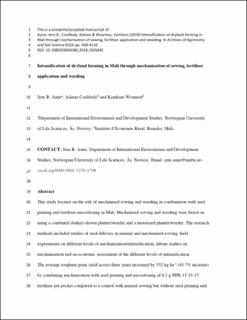| dc.contributor.author | Aune, Jens Bernt | |
| dc.contributor.author | Coulibaly, Adama | |
| dc.contributor.author | Woumou, Kamkam | |
| dc.date.accessioned | 2020-08-03T09:03:17Z | |
| dc.date.available | 2020-08-03T09:03:17Z | |
| dc.date.created | 2018-10-16T16:08:06Z | |
| dc.date.issued | 2019 | |
| dc.identifier.citation | Archives of Agronomy and Soil Science. 2019, 65 (3), 400-410. | en_US |
| dc.identifier.issn | 0365-0340 | |
| dc.identifier.uri | https://hdl.handle.net/11250/2670615 | |
| dc.description.sponsorship | This study focuses on the role of mechanised sowing and weeding in combination with seed priming and fertiliser microdosing in Mali. Mechanised sowing and weeding were based on using a combined donkey-drawn planter/weeder and a motorised planter/weeder. The research methods included studies of seed delivery in manual and mechanised sowing, field experiments on different levels of mechanization/intensification, labour studies on mechanisation and an economic assessment of the different levels of intensification. The average sorghum grain yield across three years increased by 352 kg ha−1 (43.7% increase) by combining mechanisation with seed priming and microdosingof0.2gNPK15-15-15fertiliserperpocketcomparedtoacontrol with manual sowing but without seed priming and microdosing. The labour demand (sowing and weeding) for manual, donkey-drawn and motorised operations was 184, 67 and 47 hours ha−1, respectively. An economic analysis showed that the donkey-drawn planter/weeder is the appropriate mechanisation below six ha while above this land size it becomes increasingly interesting for the farmers to invest in a motorised planter. The use of mechanisation will result in earlier and uniform crop establishment, facilitate microdosing application, timelier weeding, higher yields, better economic return and reduced labour demand. | en_US |
| dc.language.iso | eng | en_US |
| dc.rights | Attribution-NonCommercial-NoDerivatives 4.0 Internasjonal | * |
| dc.rights.uri | http://creativecommons.org/licenses/by-nc-nd/4.0/deed.no | * |
| dc.title | Intensification of dryland farming in Mali through mechanisation of sowing, fertiliser application and weeding | en_US |
| dc.type | Peer reviewed | en_US |
| dc.type | Journal article | en_US |
| dc.description.version | acceptedVersion | en_US |
| dc.source.pagenumber | 400-410 | en_US |
| dc.source.volume | 65 | en_US |
| dc.source.journal | Archives of Agronomy and Soil Science | en_US |
| dc.source.issue | 3 | en_US |
| dc.identifier.doi | 10.1080/03650340.2018.1505042 | |
| dc.identifier.cristin | 1620869 | |
| dc.relation.project | Utenriksdepartementet: 7850060003 | en_US |
| cristin.unitcode | 192,13,1,0 | |
| cristin.unitname | Institutt for internasjonale miljø- og utviklingsstudier | |
| cristin.ispublished | true | |
| cristin.fulltext | postprint | |
| cristin.qualitycode | 1 | |

